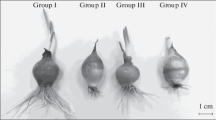Abstract
Sesbania cannabina a multipurpose leguminous crop of family Fabaceae, is widely adaptable to adverse climatic conditions such as waterlogging, drought and high salinity. Flooding and water logging are very common phenomena and there may be possibility to become more serious alarms for environment, which is progressively deteriorated by human beings by their anthropogenic activities, polluting the atmosphere. Flooding provides a case of natural selection to the nature which selects the plants which are more adaptable to this condition and renders themselves to survive due to this tolerance or resistance behavior. Present study envisages the effect of waterlogging stress on chromosomal biology of Sesbania pea. To study the effect of waterlogging stress on microsporogensis of Sesbania cannabina, presoaked seeds were sown in experimental pots. Permanent waterlogged condition is created by shifting pots in water filled tanks. Cytological studies showed various types of chromosomal aberrations induced by waterlogging stress and reduction in pollen fertility was also encountered.
Similar content being viewed by others
References
Maryam, A. and Nasreen, S., A review: water logging effects on morphological, anatomical, physiological and biochemical attributes of food and cash crops, Int. J. Water Res. Environ. Sci., 2012, vol. 1, no. 4, pp. 113–120.
Hossain, M.A. and Uddin, S.N., Mechanisms of waterlogging tolerance in wheat: morphological and metabolic adaptations under hypoxia or anoxia, Austral. J. Crop Sci., 2011, vol. 5, no. 9, pp. 1094–1101.
Kozlowski, T.T., Responses of woody plants to flooding and salinity, Tree Physiol., Monograph no. 1, Victoria: Heron Pub., 1997.
McNamara, S. and Mitchell, C., Differential flood stress resistance of two tomato genotypes, J. Amer. Soc. Hort. Sci., 1989, vol. 114, pp. 976–980.
Voesenek, L.A.C.J., Benschop, J.J., Bou, J., Cox, M.C.H., Groeneveld, H.W., Millenaar, F.F., Vreeburg, R.A.M., and Peeters, A.J.M., Interaction between plant hormones regulate submergence-induced shoot elongation in the flooding-tolerant dicot Rumex palustris, Ann. Bot., 2003, vol. 91, pp. 205–211.
Gibbs, J. and Greenway, H., Mechanism of anoxia tolerance in plants. 1. Growth, survival and anaerobic catabolism, Funct. Plant Biol., 2003, vol. 30, pp. 353–353.
Ponnamperuma, F.N., Effects of flooding on soils, in Flooding and Plant Growth, Kozlowski, T.T., Ed., Orlando: Acad. Press, 1984, pp. 9–45.
Krolova, M., Clzkova, H., Hejzlar, J., and Polakova, S., Response of littoral macrophytes to water level fluctuations in a storage reservoir, Knowl. Manag. Aquatic Ecosyst., 2013, vol. 408, pp. 07p1–07p21.
Heckenberger, U., Schurr, U., and Schulze, E.-D., Stomatal response to aba fed into the xylem of intact Heliarthusannuus (L.), Plant J. Exp. Biol., 1996, vol. 47, pp. 1405–1412.
Rizhsky, L., Liang, H., and Mittler, R., The combined effect of drought stress and heat shock on gene expression in tobacco, Plant Physiol., 2002, vol. 130, pp. 1143–1151.
Singh, S. and Gupta, P.K., Effect of high temperature on chiasma frequency in irradiated Chrysanthemum segetum, in Perspectives in Cytology and Genetics, Manna, G.K., Ed., Delhi: Hindasia, 1981.
Author information
Authors and Affiliations
Corresponding author
Additional information
The article is published in the original.
About this article
Cite this article
Srivastava, N., Kumar, G. Effect of waterlogging stress on meiotic course, tetrad formation and pollen fertility of Sesbania pea. Cytol. Genet. 50, 28–31 (2016). https://doi.org/10.3103/S0095452716010096
Received:
Published:
Issue Date:
DOI: https://doi.org/10.3103/S0095452716010096




